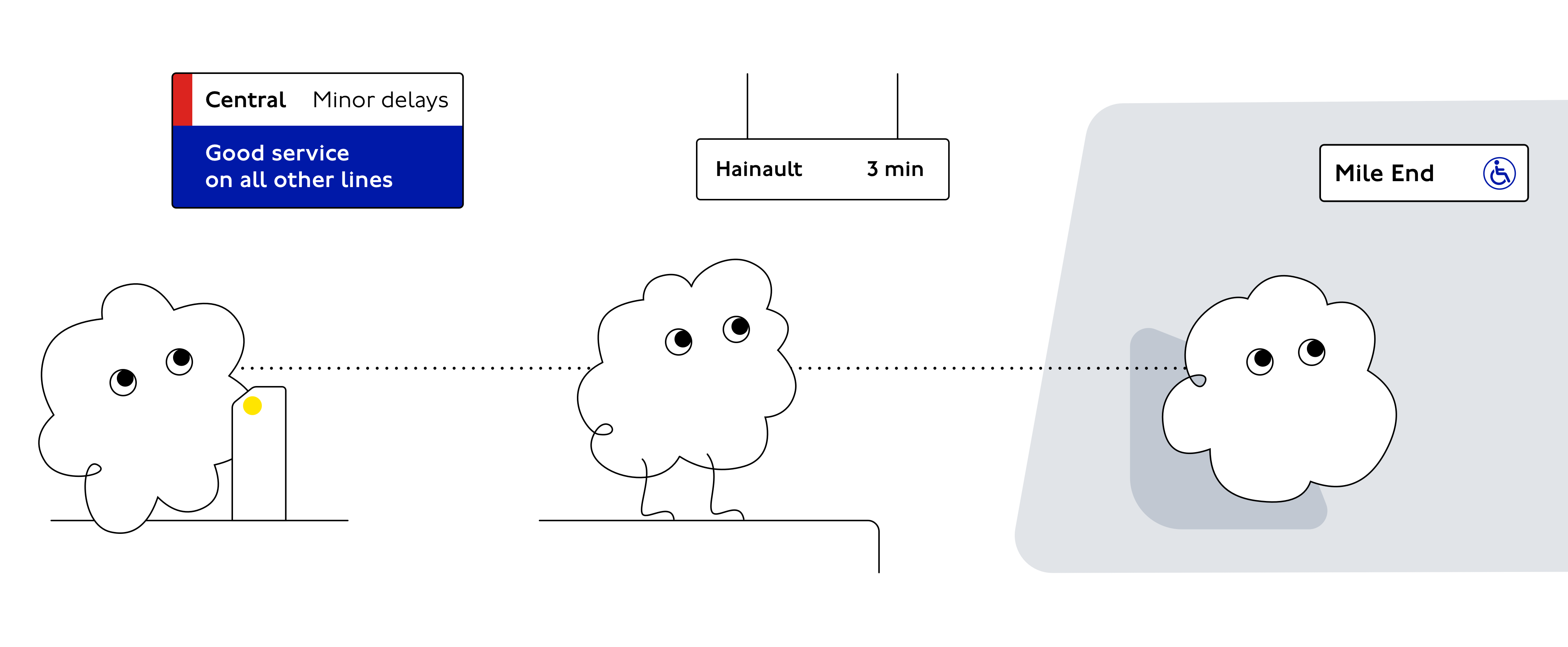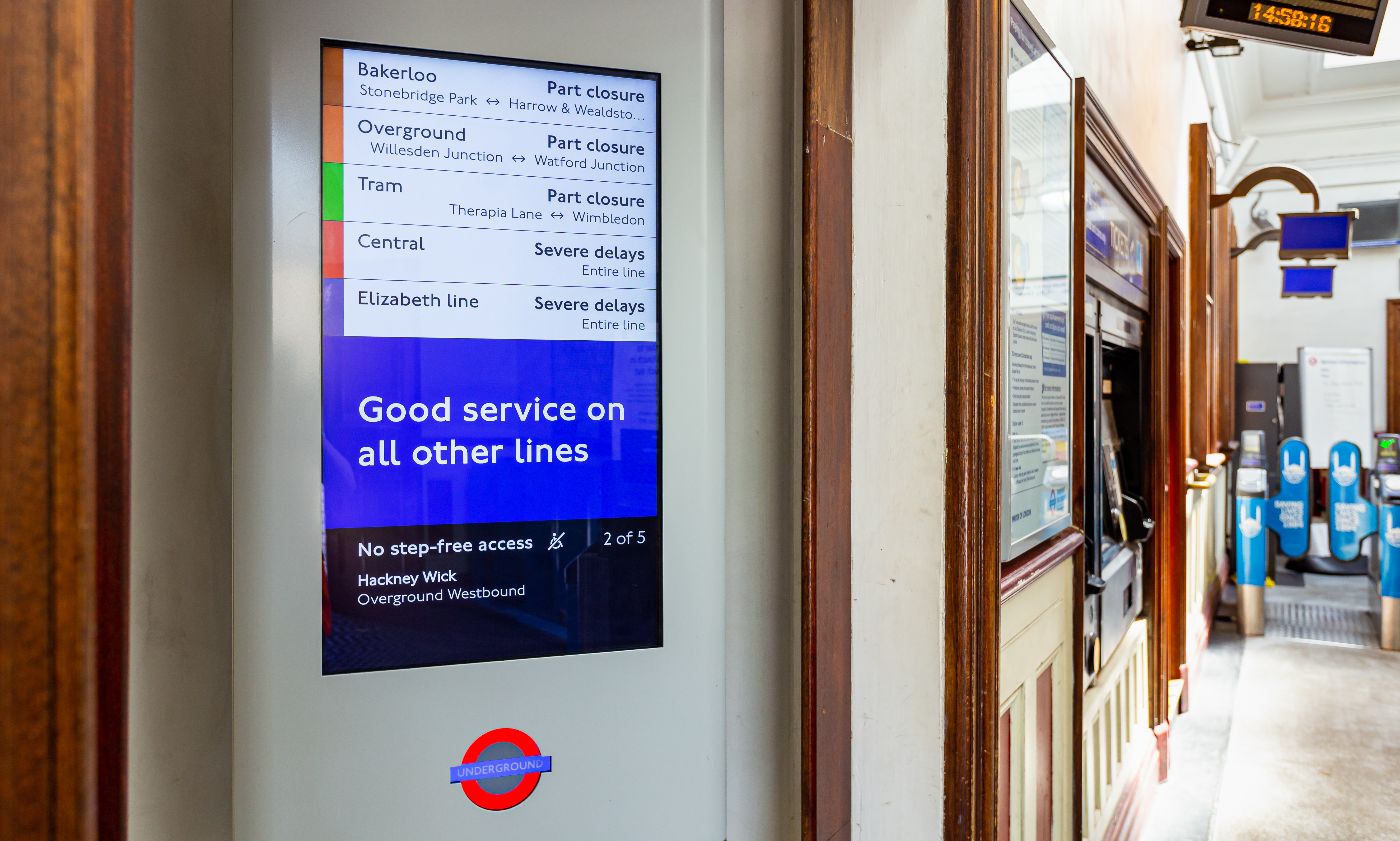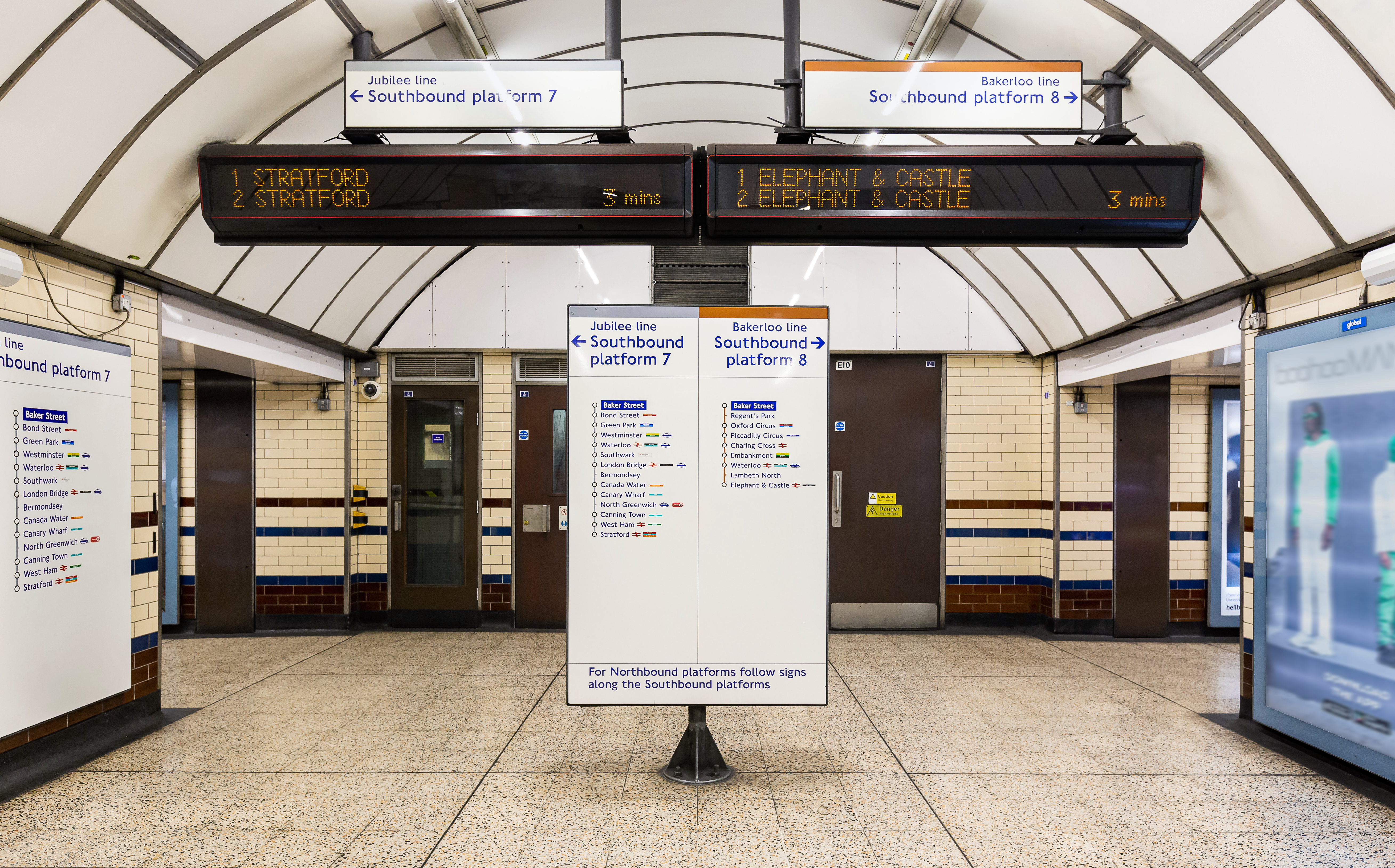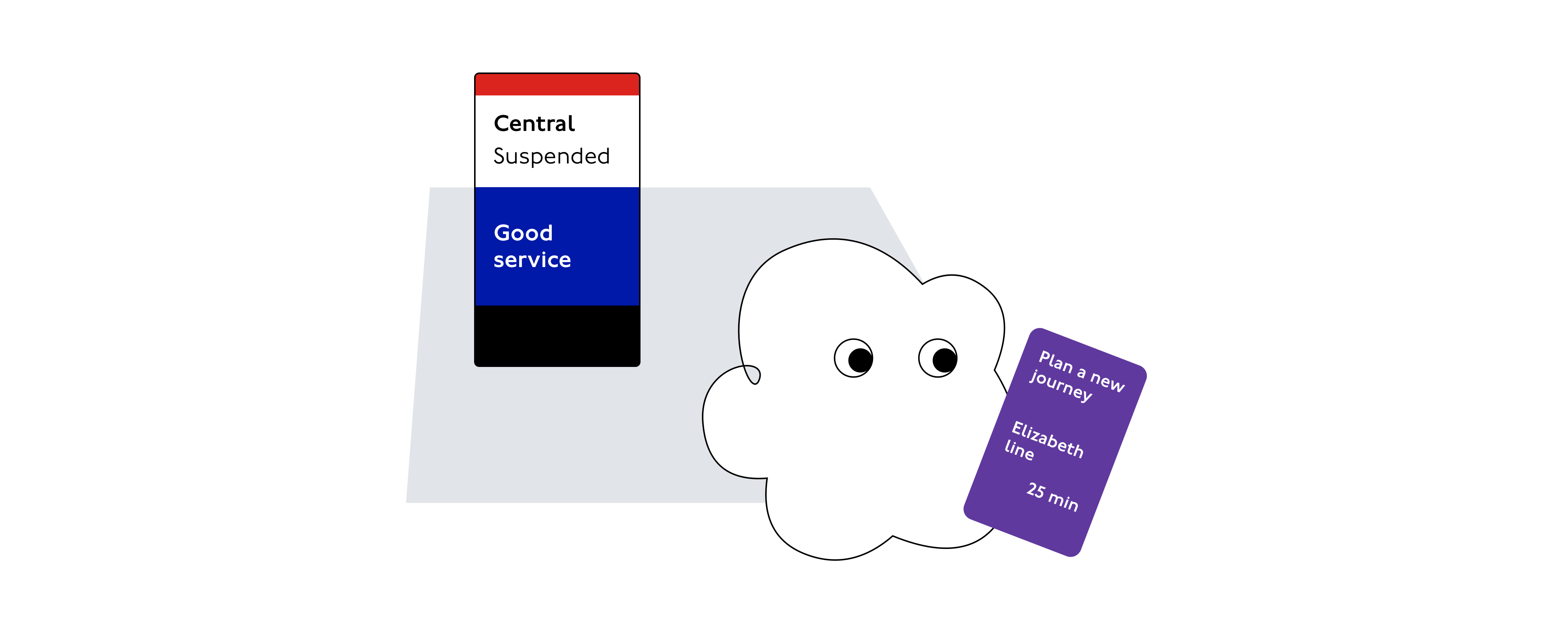Customers traveling on the TfL network encounter many information touchpoints that help them confidently continue their journey.
This article focuses on how customers interact with Digital displays.
Its aim is to help us and our partners make the most of each screen, by understanding their unique context and role in the customer journey.
Digital displays share live, data-driven, relevant, timely information that supports decisions at key moments – often at a split-second glance.
- This may be a decision around the comfort of their journey: (“How busy will the next train be? When will things get quieter?”)
- Or a decision in the event of a disruption: (“How delayed is my train and what other routes could get me to my destination?”).
They are sometimes referred to as “Customer Information Screens” and are separate from advertisement screens.

Customers encounter Digital Displays at different points in their journey:
- In station concourses
- On platforms
- In Vehicles
- At bus stops and shelters
They often exist side-by-side with other sources of information, such as maps, printed posters, wayfinding and audio announcements. These all work together to form a clear and cohesive experience that provides customers the information they need, when they need it.
Customer journey touchpoints
Digital displays support customers at different moments in their journey, helping them make key decisions. Customer mindsets and needs vary, from entering a ticket hall, to waiting on a platform, to travelling onboard a vehicle.

Customer mindsets and needs vary, from entering a ticket hall, to waiting on a platform, to travelling onboard a vehicle. Different types of information and levels of detail will be appropriate in supporting decision-making at these different touchpoints.
Understanding customer needs helps decide where a piece of information might have the most impact, where it might be essential or non-essential.
For instance, paying to use the network is a key decision point in a customer’s journey. What information about their onward journey do they need before they tap in?
- A suspension of a line of transport leaving from their station is essential information to be aware of before crossing the gateline, since it could stop them from completing their journey.
- Meanwhile, knowing the platform their train leaves from won’t impact their decision to travel or to pay for their journey, so it isn’t considered essential at the gateline. This information will become relevant at the next decision point, when they’ve crossed the gateline and need to navigate the station to continue their journey.
This focus on essential information ensures we manage the limited space on digital displays, by only showing relevant information to customers at key decision moments.
Entering or exiting a station
Customers entering or exiting a station will have different needs:
- Screens facing customers entering a Tube station might show network status for the rest of the Tube, or service departure times.
- Screens facing customers exiting a station might show nearby bus departures, local interchanges and local landmarks.

Time of day
Customer needs also change depending on the time of day.
Some screens may have the capacity to adapt the type of information shared to match those needs.
- During a busy morning peak, information about upcoming planned closures might be less relevant to customers focused on getting the next train.
- However, later in the evening, when customers are travelling home, especially ahead of a weekend, information about upcoming planned closures on their local lines would be much more relevant and likely to make an impact on their future travel.
Physical context of the screen
The physical environment shapes how customers interact with digital displays. Understanding this context is fundamental to designing their customer experience.
A wide range of digital displays exist across the TfL network, placed across different environments, from large entrance halls to onboard vehicles.
These screens vary in:
- Size
- Placement
- Display resolution
- Age
- Hardware and software technology
- Energy efficiency…
These all have a great impact on defining how best to format information.
Display size and distance
The placement (distance from the viewer, including height) and size of the screen are particularly important to take into consideration.
- A smaller screen at eye-level would be obscured in a crowd, so one would expect to be able to get closer to it and inspect it in detail.
- On the other hand, a large screen installed higher up would allow multiple people to quickly glance at it while moving past.
The type and format of information on each screen should be consistent with these interactions, to ensure screens are useful and legible at an appropriate viewing distance.
It’s important to keep in mind that the further away text is meant to be legible, the bigger the text size will need to be. This has consequences on the amount of information the display will contain, and highlights the importance of focusing on essential information.
Surrounding environment
The built environment surrounding the display can also have a big impact on the perception of a digital display.
If a display is in a large or narrow space, indoors or outdoors, if it’s in direct sunlight or sheltered away, if it’s hidden behind a column… These factors affect the visibility of the display, so decisions must be made on the format of the information to ensure it remains clear and legible.
Digital displays are most impactful when the live information they share is relevant to the physical environment in which they are placed.
- A display by a lift might be a good place to share step-free information (for example, if any other station lifts are experiencing issues throughout the network.)
- A display on a platform could indicate where to wait to board a quieter carriage on the next train.
Relationship with wayfinding
Digital displays often exist side-by-side with wayfinding, which customers rely onto navigate stations and stops.
Any information shared on displays that is not aligned with nearby wayfinding creates confusion and damages trust in both the displays and the signage.
- If a digital display is installed near wayfinding about a specific line or a given direction, the display should share live information about that line or direction as well, to ensure a coherent experience.

Relationship between digital displays and mobile apps
While we know some customers use travel apps on their mobile devices to support their journey, digital displays make live, accurate, relevant information accessible to customers regardless of their personal use of technology.
Digital displays have the benefit of sharing relevant information directly in the station environment, so customers encounter the information they need when they need it. We expect this to improve customers’ journeys and safety, helping them move more smoothly through stations, reducing the risks associated with stopping and checking their phones in busy stations.
Handing off to personal devices
On the other hand, a digital display can only fit a certain amount of information before its glanceability and legibility become compromised.
When a large amount or complex information needs to be shared, some screens may have to show a high-level summary, and direct customers to find out more by speaking to staff or using an app on a personal device.
We suggest mentioning our travel app: “Find out more on TfL Go”.

Consider the relationship between information on personal devices, like websites and apps, and the displays in stations. Displays should provide confirmation of the information customers may have gathered ahead of travelling, giving them confidence to continue their journey.
The goal is to establish a complimentary relationship between the multiple tools at a customer’s disposal, rather than replication.
- A digital display at a station entrance could share more abstract, general information about a disruption and include a hand over message to TfL Go. This would raise customers’ attention, informing them that their journey may be impacted, but encouraging them to look for more in-depth information.
Align with TfL’s global, inclusive design language.
TfL Digital products are designed according to our design principles.
As well as drawing from TfL’s rich design heritage and iconic style, we design our digital products to be inclusive and accessible to all.
The design of digital displays is no exception. The layout and typographic choices of a display make a huge impact on its legibility and clarity.
We’ve created a set of foundational design guidelines to help third parties and suppliers design inclusively and thoughtfully, ensuring new digital displays align with our design language.
To get in touch with the Digital team, contact [email protected]
© Transport for London
